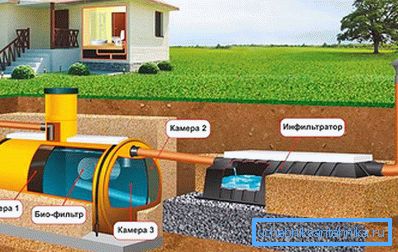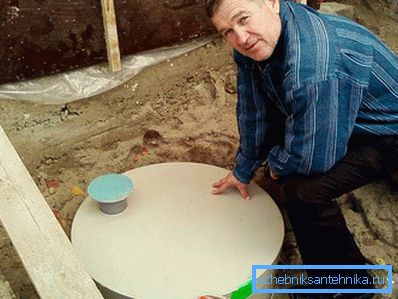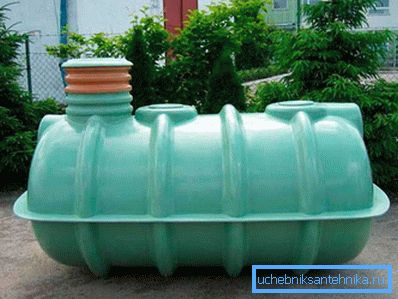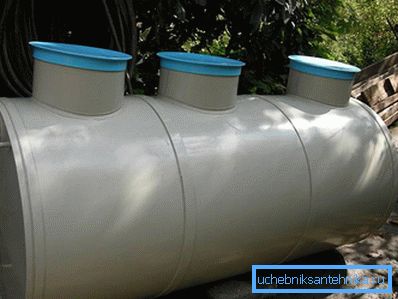Bioseptics for a country house
In many private homes it is simply impossible to connect to the general city sewer system. In this regard, some people have to save on the amount of water consumed and inconvenience. To make life easier, you can use bioseptics for a country house, which makes it possible to once and for all abandon cesspools, using as much water as necessary, without polluting the environment. What is a bioseptic and can I install it myself? Now we will understand.
Most types of septic tanks are devices that have a compact form and low cost. Their quality is guaranteed by manufacturers, and it fully meets all the requirements for sewage treatment imposed on sewage in our time. Bioseptics are autonomous wastewater treatment plants that are ideal for filtering drains and carrying out their bioremediation using aeration.
What are the advantages of bioseptic?
- The service life of the tank is not less than 30 years. This is due to the fact that the material for the manufacture of its body is stabilized propylene, resistant to corrosion and other harmful effects.
- The drains are cleaned by almost 100%, so they can be safely displayed in the nearby located ground.
- Routine maintenance is needed no more than once every couple of years.
- When installing a septic tank, it is not necessary to order heavy machinery, since the septic tank is lightweight and has mounting loops.
- The cleaning system works without unpleasant odors, as it happens with ordinary cesspools. This makes it possible to install septic tanks near buildings (but not closer than the allowable distance).
- The cleaning system can work without electricity in case of its shutdown.
- A compressor in a septic tank can work for at least 15 years (the country of origin is Japan).
- Not all septic tanks work only with electricity - you can order a septic tank that cleans drains without being connected to the power grid.
- The case is completely waterproof, so you can not be afraid of the ingress of untreated sewage into the surrounding soil.
Septic tank device

A typical septic tank consists of three or four chambers. In the first of these chambers comes water that is highly polluted and has not passed a single stage of purification. In this chamber, most of the pollution is deposited. In the next, second chamber, silt and parts of garbage that have passed the first chamber are deposited at the bottom. In the third chamber, all deposits are recycled and aerated. When the water reaches the last, fourth chamber, it is completely purified.
It is important to pay attention to the performance of the septic tank - this is the main criterion. If productivity is low, then the septic tank will not cope with the volumes of effluent flowing into it. At the same time it will not mean that the septic tank is faulty or poorly executed. The whole problem will be that when choosing it, its performance was not determined.
What design septic tank choose

A septic tank is a kind of container that has a certain volume. In it, together with accumulated effluent, the sedimentation of organic elements and their biological destruction can occur. In short, the contents of the sewage system is not just collected in a pit, but also processed in a septic tank.
There are autonomous sewers with different structures. They can be represented by conventional containers, without any special functions, suitable for pumping machines. More complex systems are sewage treatment plants that purify water almost completely - some even decide to try it as a drinking water.
Cumulative septic tanks can rightly be considered the most accessible - their simplest design allows them to be inexpensively purchased. However, such systems are completely unsuitable for owners of country cottages, who usually use water in large quantities, which leads to rapid filling of the tank and frequent pumping. Such septic tanks are not suitable for those who visit their property so often, so the septic tank is not filled quickly. Well, if we are talking about permanent residence, then it is best to install recyclable waste into the soil in your bioseptic system without harm to the soil. You can also install such bioseptics for cesspools.
Bioseptic installation

During the installation of the septic tank should follow the recommendations that are given by the manufacturer of a tank for wastewater. There are also requirements for the minimum distance from the septic tank to certain objects:
- the distance from the open well or dug hole in sandy soil is not less than 50 m;
- if there are natural reservoirs nearby - 30 m;
- the distance from the apartment building and other buildings is about 5 m and more;
- trees and highways should be at least 4 m away from a septic tank.
In general, those companies that sell septic tanks usually offer and install them. If a person does not want to spend his time and energy - then this solution is optimal. In most cases, installing a septic tank with your own hands is not difficult, except for the associated with this huge amount of earthworks.
Tip! Measuring the depth of the pit, it is worth considering that it will be necessary to make a sand pad 10–20 cm thick under the septic tank. In other cases, before installing the tank, you may need to lay a concrete slab on the bottom or even arrange a small foundation.
The process of installing a septic tank consists of several stages:
- First of all, the trench is pulled out into which the container will be placed. Dimensions of the pit are calculated taking into account the fact that the septic tank will have to fit in it easily.
- The next stage is digging trenches for sewer pipes. Among such pipes there may be those by which water will be supplied to the septic tank and removed from it, as well as drainage pipes. The depth of the laying of pipelines may vary, with the main role played by the soil and the construction of the septic tank. In particularly cold climatic zones, pipes should be insulated. A sand cushion up to 30 cm thick is compacted on top of the pipe. The average trench depth is usually from 50 cm to 1 m, with a width of about 40 cm.
Tip! Digging a pit, it is important to take into account the depth of groundwater. In some types of septic tanks, instructions may require that the tank be insulated. In almost all models, but provided that the septic tank is filled with clean water, side filling with sand is performed, about 30 cm thick.
Useful tips

How to maintain septic tanks? The main requirement to be followed when servicing septic tanks is its timely cleaning of accumulated sludge deposits and other drains that do not dissolve quickly, but are deposited on the walls and settle to the bottom.
To help the septic tank really help to cope with sewage, it needs to be purchased only from reliable suppliers and in stores that have proven themselves to many buyers. And the advice - if you are not sure that you can cope with the installation of a septic tank, then it is better to deal with this issue or contact the experts.
In fact, it’s not so difficult to understand how to put a septic tank. To do this, you can watch the video at the end of the article or consult with friends on this issue.
We also recommend that you read the articles that describe the installation of bioseptics:
- Separator from plastic drums do it yourself.
- Septic tank of concrete rings do it yourself.
- Installation of a Septic tank with his own hands.
- Septic from Eurocube with their own hands.
- Installing a septic tank with your own hands.
A photo






Video
Choose a septic tank for a country house or cottage:
This video is a construction instruction for a septic tank made of reinforced concrete rings: